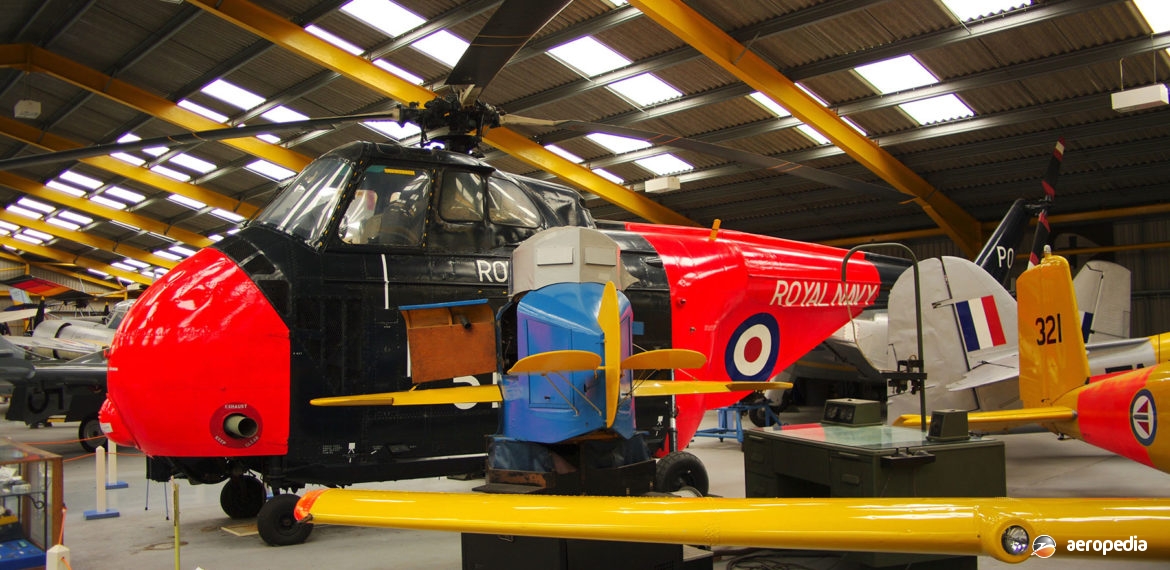Photograph:
Westland Whirlwind HAS-7 XM685 / G-AYZJ at the Newark Air Museum in the United Kingdom (David C Eyre)
Country of origin:
United Kingdom
Description:
Utility helicopter
Power Plant:
One 559 kw (750 hp) Alvis Leonides fourteen-cylinder two-row air-cooled radial engine
Specifications:
- Main rotor diameter: 16.15 m (53 ft)
- Length: 18.9 m (62 ft)
- Height: 4.03 m (13 ft 2½ in)
- Max speed: 176 km/h (109 mph)
- Max cruising speed: 148 km/h (92 mph)
- Economical cruising speed: 139 km/h (86 mph)
- Max rate of climb at sea level: 320 m/min (1,050 ft/min)
- Hovering ceiling in ground effect: 2,195 m (7,200 ft)
- Max range: 537 km (334 miles)
- Empty weight: 2,440 kg (5,375 lb)
- Loaded weight: 3,629 kg (8,000 lb)
History:
The Whirlwind was a development of the Sikorsky S-55, the prototype HAR-1 (XA862) flying for the first time on 21 August 1953 powered by a 448 kw (600 hp) Pratt & Whitney R-1340-40 radial engine. It was later delivered to the Royal Navy.
First machine delivered to the RAF was the HAR-2 (XD179), this model having the Pratt & Whitney R-1340-40 engine and was used for communications and search-and-rescue duties with Transport and Coastal Command.
In 1954 the HAR-4 was introduced to RAF service, this having the Pratt & Whitney R-1340-57 engine with a different blower ratio which made it more suitable for operations in the areas of higher temperatures such as in the tropics. This model entered service with No 155 Squadron of the RAFs Far East Air Force and was operated in Malaya for jungle rescue and troop transport operations.
In April 1955 two were supplied to the Queen’s Flight for use by the Royal Family. During the Suez crisis in 1956 Whirlwinds of the Joint Experimental Unit were operated from HMS Ocean in support of commando forces.
On 1 November 1956 the first aircraft, fitted with the British-built Alvis Leonides engine, was flown and subsequently 435 examples were built in a variety of models, the last few models up to the HCC Mk 12 being fitted with the de Havilland T-58 Gnome turboshaft.
Royal Navy Whirlwinds saw action in Sarawak in nnorth-west Borneo following raids on border villages by Indonesian terrorists, the machines operating from aircraft carriers, from Kuching, and later operating from Brunei in Borneo and other areas in the region following the confrontation by Indonesia with Malaysia in 1964. At this time armament was fitted to some, 7.7 mm (0.303 in) Browning machine guns being mounted or rocket pods containing fourteen 5 cm (2 in) rockets.
The Whirlwind also saw service in other areas, HAS-7s being converted to carry commandoes and being embarked on board HMS Albion and HMS Bulwark during the Malayan crisis in 1953. Later HAR Mk 10 Whirlwinds saw service in Cyprus during the EOKA troubles, operating from Akrotiri.
In addition to service with the British services, examples were supplied to the French Army and Navy, and a small number saw civil service with British European Airways, and operators in Cuba, Brazil, Austria, Iran, Spain, Yugoslavia, Ghana, Brunei, South Africa etc.
With the RAF the type saw service with the Anti-Submarine Warfare Development Unit, and units in the Far East where the RAF employed units during the Indonesian confrontation in 1964. During the Malayan campaign 31 examples of the HC Mk 4s were fitted with Pratt & Whitney R-1340-57 engines to better suit the tropical climate.
All Whirlwinds produced up to the HAR-5 had Pratt & Whitney engines, the later and subsequent piston-engined variants having the Alvis Leonides. The HC Mk 6 was to have the 671 kw (900 ehp) Blackburn Coupled Turmo but this did not eventuate. A prototype Whirlwind was built in 1959 with a Gnome engine by converting the redundant HAR 5 prototypes, the first aircraft so fitted flying on 28 February 1959, and production aircraft being known as the HAR-10. As a freighter the latter could carry up to 907 kg (2,000 lb), or up to six patient litters internally in the casualty evacuation role.
Examples of the type, known as the HCC Mk 8 and later the HCC Mk 12, were also operated by the Queen’s Flight.
Only a few Whirlwinds survive, mostly in museums. Late in 1993, after withdrawal from military service in the United Kingdom, a number were sold by tender from RAF stores. One of these, a Whirlwind HAS-7 (serial XM665), was obtained and shipped to Australia in 1994 and is now part of the collection of aircraft at the Museum of Flight at HMAS Albatross at Nowra, NSW, this museum later changing its name to the RAN Museum.

